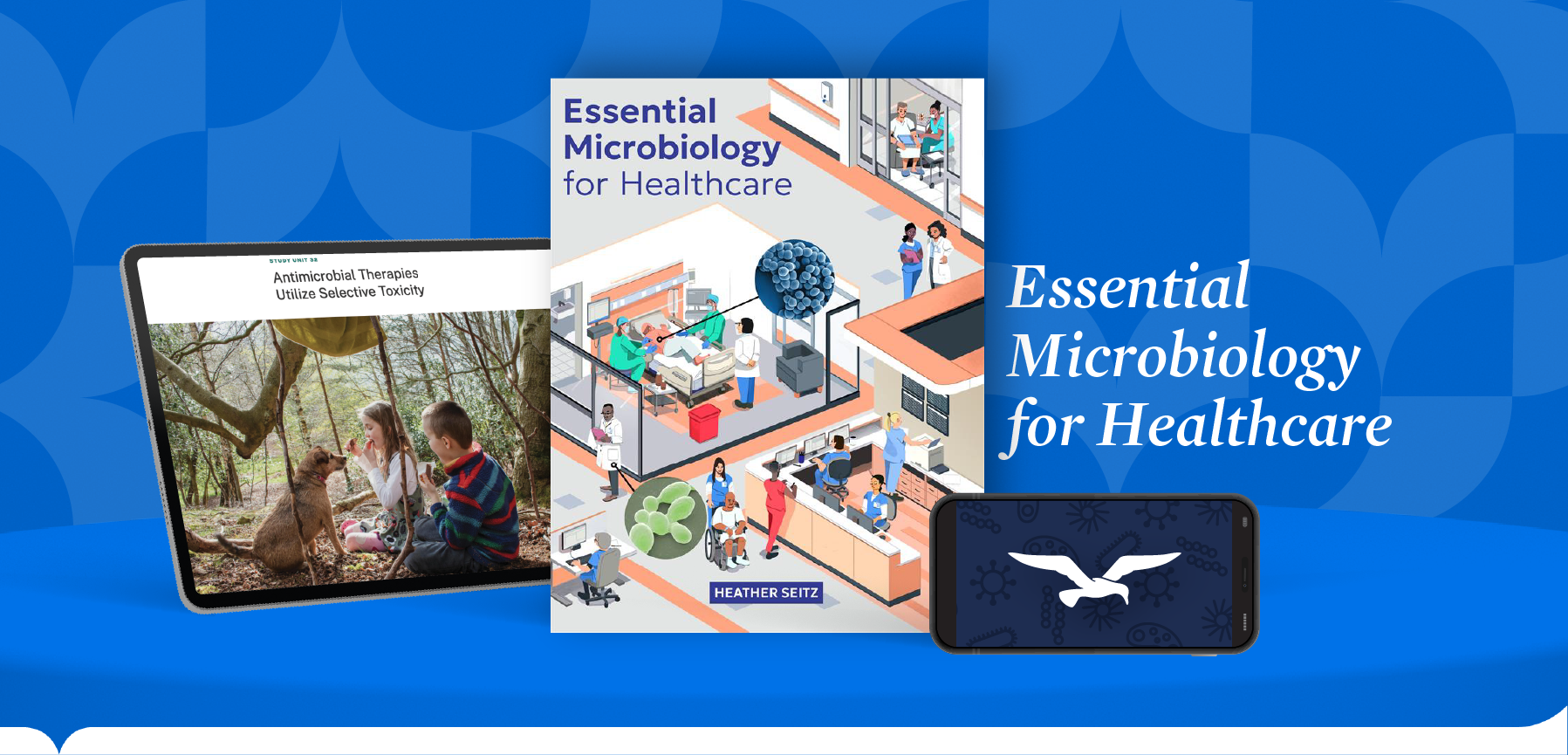

Help your students build an intentional, lasting information scaffold of microbiology concepts.
Educational research shows that scaffolding helps support lifelong learning and has lasting benefits on today’s students. Heather Seitz has created a textbook for health science–focused microbiology using this research to ensure students form a long-term, enduring understanding of the principles of microbiology and how they relate to their future healthcare careers.
This student-centered resource is for you if you’re tired of teaching with an encyclopedic reference and you desire a way to present concepts in multiple formats. The book offers a flexible structure that lets you to jump around in the content or piece together chapters.
This book will go on sale in Fall 2027, with class-testing opportunities starting in Spring 2027. To learn more, please email Courtney Zanosky or fill out the form below.
What are students saying?
We asked students from three universities to read and reflect on a Study Unit in Heather’s book. The results? Read below!
Students Rated the Study Unit
For clarity
For effectiveness
What makes Essential Microbiology for Healthcare different?

It shows how microbiology contributes to future careers for professional preparation.
Each study unit focuses on how microbes affect human health as the ultimate expression of students’ learning. This is achieved by focusing on the top 25 pathogens that affect humans and providing real-world examples. It has also been vetted by a panel of nurses and healthcare professionals to ensure it serves as preparation to get students into their desired programs.

It encourages deeper learning of applications in the context of essential concepts.
The information in this course is vast but often isn’t important for students to memorize. Heather focuses her coverage on helping students build an understanding of how pathogens work, how to control them, and how they spread in the community. This thoughtful selection allows students to understand microbes without getting overwhelmed and provides actionable opportunities to apply new knowledge.

It is informed by learning science research to help all students build an information scaffold.
We know that your students come into your class with various levels of exposure to general biology concepts and perhaps no prerequisites. Heather’s text has extensive scaffolding—students are introduced to new concepts through connections to concepts they’ve already mastered, and chunked sections help with knowledge retention.

It provides flexibility with a suite of multimodal resources that help students learn in multiple ways.
Our robust digital package offers a variety of assessment including low-stakes practice, application-based activities, and active-learning assignments. The Norton Illumine Ebook contains assignable study units with animations, interactives, and concept check questions. InQuizitive and Smartwork allow for flexibility in pre- and post-classwork.
Table of Contents
Each chapter contains 1–3 study units that are centered around essential concepts. Heather crafted her book out of learning science research that affirms students learn better through content chunking and scaffolding that connects concepts to something they already know. Chapters and study units align with the American Society for Microbiology’s Curriculum Guideline Fundamental Statements (FS) and Microbiology in Nursing and Allied Health Curriculum Guidelines (MINAH).
Chapter 1: Microbiology Impacts Our Everyday Lives
Chapter 2: Introduction to Infectious Disease and Susceptibility
Chapter 3: Visualizing Microbes
Chapter 4: The Building Blocks of Microbiology
Chapter 5: The Architecture of a Microbe
Chapter 6: Bacterial Metabolism
Chapter 7: Bacterial Growth
Chapter 8: Working with Microbes in the Laboratory
Chapter 9: Bacterial Genetics
Chapter 10: Virus Replication and Growth
Chapter 11: Eukaryotic Pathogenesis
Chapter 12: Bacterial Pathogenesis
Chapter 13: Controlling Microbial Growth
Chapter 14: Infectious Disease Outbreaks and Diagnosis
Chapter 15: The Immune System’s Response to Infection
Chapter 16: Immunological Tools and Vaccinations
Chapter 17: Immune System Disorders
Chapter 18: Nervous System Infections
Chapter 19: Respiratory System Infections
Chapter 20: Skin and Eye Infections
Chapter 21: Digestive System Infections
Chapter 22: Urinary and Reproductive System Infections
Chapter 23: Systemic Infections
The Author: Heather Seitz

Heather Seitz’s experience as a community college instructor for over 17 years, paired with being a first-generation college student herself, has informed her awareness of the impact that educational interventions can have on student success. Her research focus is on assessment in online learning and engaging non-traditional students. In 2017, she led the creation of the validated Microbiology for Health Sciences Concept Inventory, which is used nationally to measure expert thinking in microbiology focused on health science students.
As a PULSE leadership fellow, she is involved in many projects affecting change in undergraduate life sciences education and has helped engage educators in developing and implementing best practices. Formerly an editor for the Journal of Microbiology and Biology Education, Heather seeks to promote evidence-based teaching practices.
The Advisory Board
Each chapter of Essential Microbiology for Healthcare has been thoroughly reviewed by a Nursing and Microbiology Advisory Board. This is an ongoing initiative to inform the efficacy and content of Heather’s text.
Below, you can meet a few members of the board and learn what excites them most about this project!
Aimee Younkin, PhD, MSN, RN
Director of Online Nursing Education at Allegany College of Maryland
Years of Teaching Experience: 20
“… the discussion about scaffolding information and building on previous knowledge. Students have historically been forced to memorize information to survive a class. The goal to help them learn necessary information and then apply that in current and future classes is really the point of higher education.”
Lori Shank, DNP, MSN, RN, CPN
Program Director, Registered Nursing at Johnson County Community College
Years of Teaching Experience: 10
“... the relevance of creating a textbook specifically catered towards students pursuing a health science degree. Providing an interactive text can solidify the concepts and promote application of the material. Additionally, the idea of promoting ‘intentional reading’ in study units is exciting as well.”
Debra VanHouten
Life Science Instructor at Chemeketa Community College
Years of Teaching Experience: 24
“I’m excited about the shared vision that is common to Norton, Heather, and me, including support to help students truly understand a concept and be able to apply and translate it to multiple areas of their lives and [Heather’s] goal of 3+ modes of presentation (repetition in different formats is evidence-based). Also, a text with COMPELLING figures and video resources to help explain a figure as this can be extremely helpful to illustrating processes that are dynamic and microscopic.”
Sign up to get on the early-access list and receive updates


Copyright © W. W. Norton & Company, Inc. 2026







